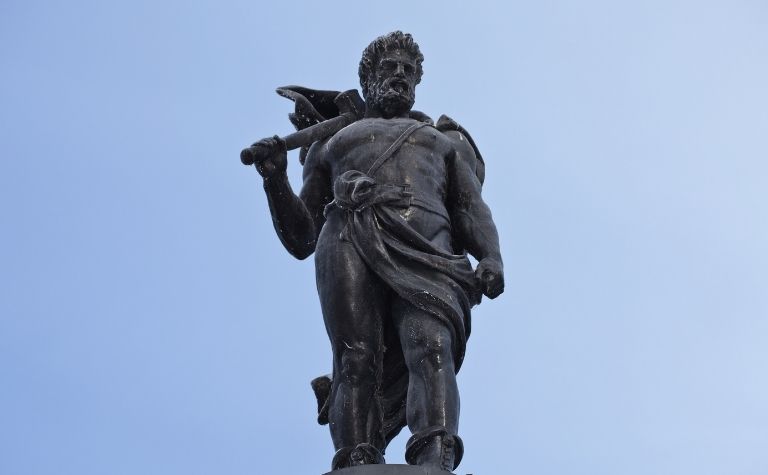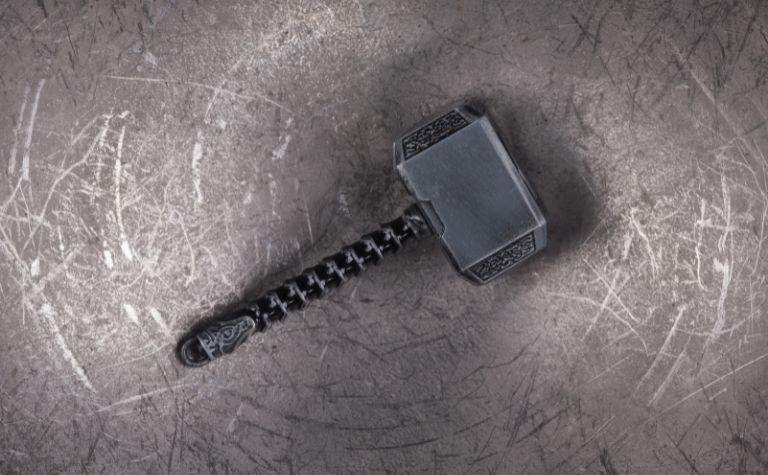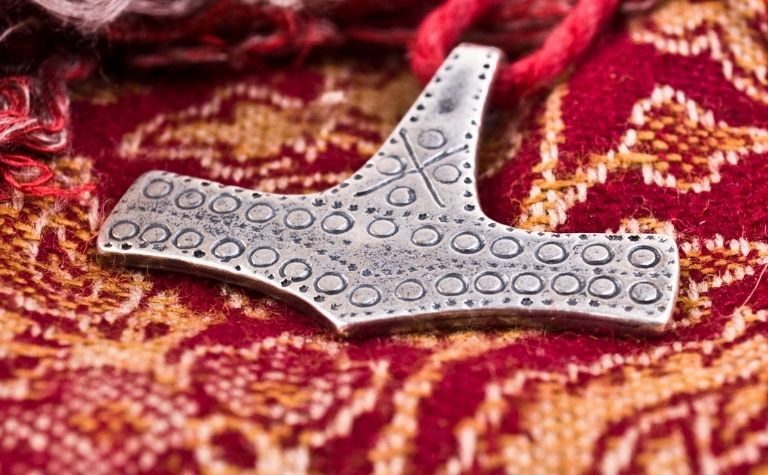The pop-culture picture of a Viking is of a giant warrior who wears a horned helmet and carries an ax, sword, or spear.
Nowhere is this image more apparent than in the professional football team, the Minnesota Vikings.
The Vikings are notable for wearing helmets with horns painted on, an image often associated with the historical Vikings and the Norse god Thor.
The Minnesota Vikings’ helmet is not supposed to be Thor’s helmet. The horns on the Vikings’ helmets evoke the idea of a Viking, even though the actual Vikings did not wear horned helmets.
The Minnesota Vikings’ logo represents the idea of a Viking and not any single figure, real or mythological.
So how did a twentieth-century football team from Minnesota become associated with thousand-year-old Norsemen? And why do the Vikings wear horned helmets?
This article will explore the relationship between the Minnesota Vikings and the historical Vikings, as well as the history of the horned helmet.
Also, see Was Thor Fat In Norse Mythology? to learn more.

What Is on the Minnesota Vikings’ Helmet?
A professional football player’s uniform includes much more than just their team colors. Their helmets are painted and decorated, often with a decal of the team’s logo on the side.
For the Minnesota Vikings, their helmet decals are different from their team’s official logo.
The Minnesota Vikings’ helmets are decorated with decals of horns.
Above the player’s ear, on both sides of the helmet, is a short horn, seemingly attached to the helmet with a gold ring.
The Vikings’ official logo also features a horned helmet. Their logo depicts the face of a Viking in profile, a blond man with a mustache, braided hair, and a purple and gold helmet with horns.
Instead of wearing this image on their helmets, the Vikings use horn decals so they appear to be wearing horned helmets, just like their mascot.
Neither the horn decals nor the Minnesota Vikings’ logo accurately represents Thor or historic Vikings. The historic Vikings did not wear horned helmets.
Horns or other ornaments on a helmet would have been dangerous in battle, as an easy handhold for an enemy to grab or by absorbing sword blows to the skull. Real horns on a helmet would be just as impractical in battle as they would be on the football field.
The Vikings’ official website suggests that the horned helmet image traces back to Richard Wagner’s series of operas called the Ring cycle.
In it, Wagner’s costume designer depicted Vikings with winged helmets. That same designer later published illustrations of Vikings wearing horned helmets.
The image has remained in the public consciousness ever since.
One Norse scholar describes the appeal of horned helmets as “the wildness of the Vikings” when they fought in a berserk state. [1]
Horns make the Vikings look like a bull, ram, or another wild animal, something beyond human. For warriors and football players alike, that animalistic image can strike fear into an opponent’s heart.
Also, see Was Thor or Zeus Stronger? to learn more.

Do the Vikings Have a Mascot Named Ragnar?
From 1994 to 2015, attendees at the Minnesota Vikings’ home games could watch a man dressed as a Viking ride his motorcycle onto the field.
Ragnar the Viking, played by Joe Juranitch, was a staple of the Vikings’ home games for over two decades. However, he is no longer the team’s mascot.
The Minnesota Vikings’ mascot is Viktor the Viking, not Ragnar. Ragnar used to be their mascot, but he was dropped in 2015 when the performer requested a steep increase in pay.
The LA Times reports that Juranitch requested a 10-year contract with a promise of $20,000 per game, which would have earned him over a million dollars per season. [2]
At the time, Juranitch made about $1,500 per game by playing the role of Ragnar. The Vikings were not willing to meet his price.
Ragnar was a unique figure in the NFL. He was the only mascot to show his real face and not wear a full-body costume.
His replacement, Viktor the Viking, is a more traditional mascot in a full, larger-than-life suit. Viktor appears to be based on the Vikings’ official logo because both men have similar physical characteristics.
Both Ragnar and Viktor wear historically inaccurate Viking helmets, much like the Minnesota Vikings’ uniform and logo.
Ragnar wore a metal helmet with large horns on the sides, which would have been impractical and possibly dangerous in battle. Ragnar’s horns stick out straight from his helmet, in contrast to Viktor’s.
Viktor wears a purple helmet that seems to be a combination of a football and a Viking helmet.
This round, purple helmet has gold accents and large horns that curve behind it. The curved horns closely resemble the horn decals on the Minnesota Vikings’ helmets.
Also, see Was Thor A Blacksmith? to learn more.

Why Is the Minnesota Football Team Called the Vikings?
The Minnesota Vikings stand out from other professional football teams because they are named for an entire state, not one city or region.
The Minnesota Vikings attract fans from all over the Midwest, regardless of rivalries between cities.
The whole Midwest region, especially Minnesota, can rally behind their football team and share Scandinavian heritage.
The Minnesota football team is called the Vikings due to the many Scandinavian settlers who populated Minnesota.
Vikings represent the Scandinavian heritage of many Minnesotans, and they are fierce historical figures, too.
Minnesota has the densest population of Swedish immigrants of all the United States, with almost 300,000 Swedes who settled there. [3]
Most of these Swedish immigrants came to America for work opportunities. They brought with them their rich Scandinavian culture–including stories of historical Vikings.
According to a newspaper article from the Minnesota football team’s founding, other names considered were the Minnesota Miners, Chippewas, and Voyageurs. [4]
Each of these names honors the state’s history.
Mining was one of the biggest industries in Minnesota. The Chippewas were the Natives who once inhabited most of the state.
The Voyageurs refer to the explorers who discovered the Mississippi River headwaters.
Conclusion
Even though they did not truly wear horned helmets, Vikings make fearsome opponents–in battle and on the football field.
Also, see Were There Black Vikings? to learn more.
